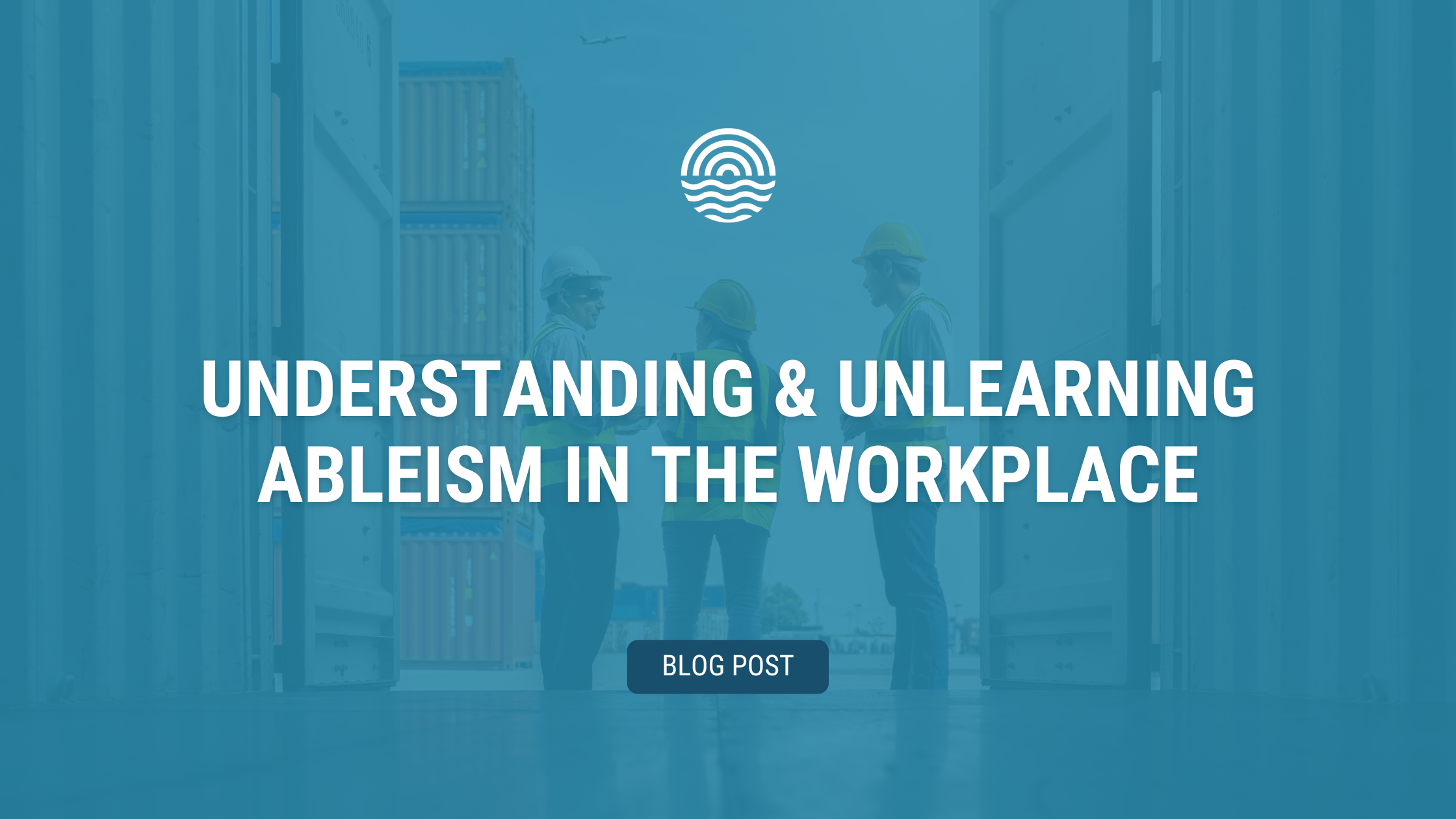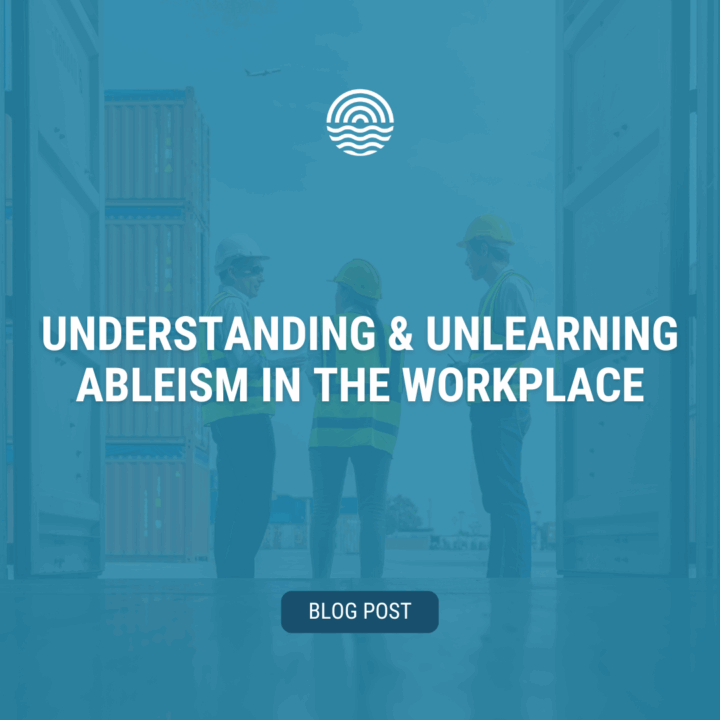
BLOG POST
UNDERSTANDING AND UNLEARNING ABLEISM IN THE WORKPLACE
We often talk about inclusion in the workplace – but to be truly inclusive, we need to talk about ableism.
While conversations around accessibility have come a long way, ableism is still deeply embedded in many of the systems, spaces, and mindsets that shape our work environments. And like other forms of bias, it often goes unspoken or unnoticed – especially by those who aren’t directly affected.
Let’s take a closer look at what ableism is, how it shows up, and what we can do to help unlearn it.
WHAT IS ABLEISM?
Ableism is discrimination, prejudice, or bias against people with disabilities. It’s based on the idea that people with disabilities are “less than” — less capable, less productive, or less valuable — and it can show up in both subtle and overt ways.
Just like racism or sexism, ableism can be individual, institutional, or systemic. It can take the form of exclusion, assumptions, language, policies, or everyday interactions that reinforce the idea that people with disabilities don’t belong — or need to “overcome” their disability in order to fit in.
WHAT CAN ABLEISM LOOK LIKE?
Ableism can be:
- Physical: Buildings without ramps or elevators, or desks that don’t accommodate mobility aids.
- Attitudinal: Assuming someone with a disability can’t do a job, speak for themselves, or be a strong leader.
- Systemic: Hiring practices that favour speed over accessibility, or lack of accommodations in performance reviews.
- Linguistic: Using phrases like “that’s so lame,” “crippled by fear,” or “turning a blind eye” without thinking about their origins or impact.
- Cultural: Celebrating productivity and hustle culture in ways that exclude those with chronic illness, neurodivergence, or fluctuating capacity.
RELATED TERMS THAT ARE HELPFUL TO KNOW
Here are a few related concepts that are helpful when learning about ableism:
- Accessibility: Accessibility is defined by the Government of Canada as “enabling persons with disabilities to live independently and participate fully in all aspects of life, having access to all aspects of society on an equal and equitable basis with others.”
- Disability: Disability is a complex phenomenon and there is no single definition of disability. With that in mind, the Accessible Canada Act defines disability as “any impairment, including a physical, mental, intellectual, cognitive, learning, communication or sensory impairment — or a functional limitation — whether permanent, temporary or episodic in nature, or evident or not, that, in interaction with a barrier, hinders a person’s full and equal participation in society.”
- Neurodivergence/neurodivergent: The Canadian Centre for Diversity and Inclusion defines neurodivergence as “having a style of neurocognitive functioning that is significantly different from what is considered ‘typical’ by societal standards.”
5 STEPS TO UNLEARN ABLEISM
Unlearning ableism doesn’t happen overnight — but it can start with small, intentional steps. Here’s how to begin:
- Reflect on your own biases. We all carry unconscious beliefs shaped by the world around us, and ableism is no exception. Reflecting on your own biases means taking a step back to question assumptions you may not even realize you’re making. For example, do you ever assume someone with a disability can’t do something — before they’ve even told you what they need? The goal isn’t to feel guilty, but to grow. When we understand where bias shows up, we’re better equipped to interrupt it.
- Use inclusive language. Swap out ableist phrases and default to person-first or identity-first language, depending on what individuals prefer. For example, use “person living with a disability” or “person with a disability” instead of “disabled person.”
- Prioritize listening to lived experiences. Nothing replaces listening to the voices of those who have first-hand experience living with a disability. Follow activists, read personal narratives, and pay attention to the feedback and needs of people with a disability in your organization.
- Design for inclusion from the start. Accessibility shouldn’t be an afterthought. Whether you’re planning a meeting, writing a job ad, or creating a new policy, design with the understanding that people with disabilities are already part of the conversation.
- Challenge norms. Rethink how performance is measured. Celebrate rest. Allow flexibility in how people show up and contribute. Inclusion and accessibility are simply about removing unnecessary barriers.
FINAL THOUGHTS
Ableism, like any form of bias, is something we’ve absorbed from the systems around us. But the more we recognize it, the more we can challenge it — in ourselves, in our workplaces, and in the spaces we influence.
Disability inclusion isn’t just about compliance or accommodations — it’s about respect, equity, and belonging. When we remove barriers for some, we make things better for everyone!
ADDITIONAL LEARNING RESOURCES
- Center for Disability Rights: Ableism
- AccessLiving: Ableism 101
- Accessibility.com: Recognizing and Countering Ableism in the Workplace
- Humi: Confronting ableism in the workplace: What it is and how to combat it
Ready to take the next step toward building a more inclusive, accessible workplace?
The Waterfront DEI Council offers tools, training, and support to help our members and their teams unlearn ableism, design with inclusion in mind, and create spaces where everyone can thrive — with no one left behind.
Connect with us to learn how we can support your accessibility and inclusion efforts.


